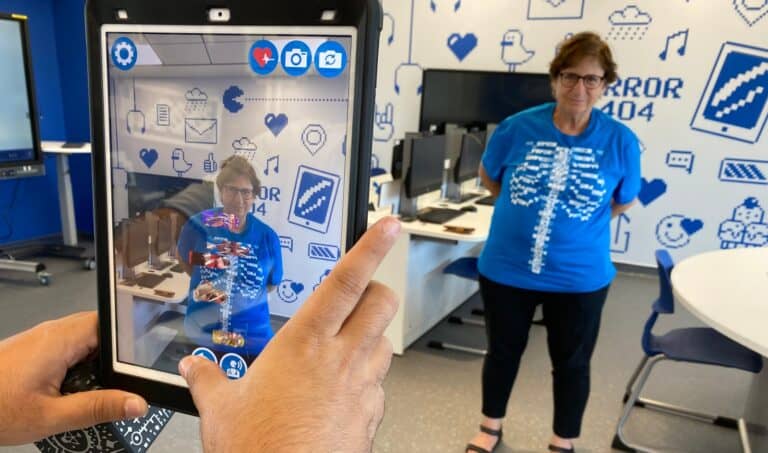A classroom where teachers and kids have fun, and succeed
When I was in fourth grade, a classmate brought in “X-ray glasses� he’d obviously gotten out of a cereal box. Peering through the plastic lenses, he claimed he could see our teacher’s skeleton. Yeah, right.
But he was only a few decades ahead of his time.
Thanks to the magic of augmented reality, kids can now point a tablet at a special t-shirt won by their teacher to view the location and function of her heart, liver, bones, circulatory system and other organs.
I saw this for myself during a tour of the digitized, gamified innovation centers for teaching and learning at Gordon College of Education in Haifa.
Prof. Rhonda Berger Sofer, director of the college’s International Center, wriggled into the AR-enabled t-shirt and suddenly I was seeing an anatomy lesson my fourth-grade classmate could never have imagined.

Prof. Rhonda Berger Sofer demonstrates an AR technology that lets students “see� inside the teacher’s body. Photo by Abigail Leichman
The classroom of yesteryear doesn’t match the needs of instructors or pupils, Sofer says.
“Unfortunately, classrooms haven’t changed for a couple hundred years – the teacher in front, the students sitting in rows of desks. The room you see here is about learning through doing, engaging the students through different senses,� she explains.
Mistake-based learning uses failure as a launchpad
Israel’s startup culture is renowned for accepting failure and leveraging its lessons for future success. The Center for Excellence in Teaching at Gordon College of Education in Haifa has leveraged that culture in its training for mistake-based learning (MBL). “If until today we saw mistakes as a negative element in learning, in the new concept we teach educators and students to embrace the mistake and build success,� says Yossi Bar, head of the Center for Excellence in Teaching.
Read moreUsing the senses
At an interactive sand table, kids can see and feel aspects of geography, topology and climatology — how lava flows in a volcano, how the seasons change.
At a touchscreen table, they can launch puzzles, quizzes and simulations of flying into space, going on safari in Africa, or exploring ancient Rome.
On the floor, they can play virtual math and geography games using their feet.
“Instead of hearing boring facts about earthquakes, you are engaged in a very exciting way and will remember the lessons better,� says Sofer.
“For a kid who doesn’t have the patience to sit still, if he can feel and see and understand he may be motivated to open the textbook.�Raising the status of teachers
Gordon’s International Center is involved in knowledge exchange, research and joint innovation with many countries, geared to training teachers of the present and future.
